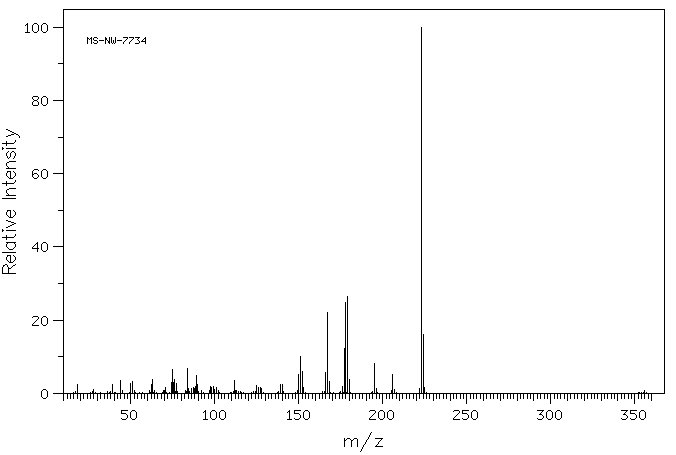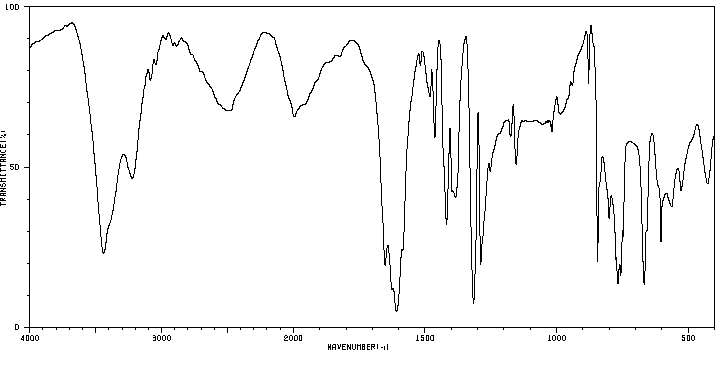9-吖啶羧酸 | 5336-90-3
中文名称
9-吖啶羧酸
中文别名
9-羧基吖啶;9-吖啶甲酸
英文名称
acridine-9-carboxylic acid
英文别名
9-acridinecarboxylic acid;9-carboxyacridine
CAS
5336-90-3
化学式
C14H9NO2
mdl
MFCD00009734
分子量
223.231
InChiKey
IYRYQBAAHMBIFT-UHFFFAOYSA-N
BEILSTEIN
——
EINECS
——
-
物化性质
-
计算性质
-
ADMET
-
安全信息
-
SDS
-
制备方法与用途
-
上下游信息
-
文献信息
-
表征谱图
-
同类化合物
-
相关功能分类
-
相关结构分类
物化性质
-
熔点:290 °C (dec.)(lit.)
-
沸点:480.4±18.0 °C(Predicted)
-
密度:1.366±0.06 g/cm3(Predicted)
-
溶解度:可溶于酸性水溶液(非常轻微,超声处理)、碱水溶液(轻微)、DMSO(轻微
-
稳定性/保质期:
在常温常压下保持稳定。
计算性质
-
辛醇/水分配系数(LogP):3.1
-
重原子数:17
-
可旋转键数:1
-
环数:3.0
-
sp3杂化的碳原子比例:0.0
-
拓扑面积:50.2
-
氢给体数:1
-
氢受体数:3
安全信息
-
安全说明:S26,S36
-
WGK Germany:3
-
海关编码:2933990090
-
危险品标志:Xi
-
危险类别码:R36/37/38
-
危险性防范说明:P261,P305+P351+P338
-
危险性描述:H315,H319,H335
-
储存条件:请将药品存放在避光、阴凉干燥的地方,并密封保存。
SDS
| Name: | Acridine-9-Carboxylic Acid Hydrate Material Safety Data Sheet |
| Synonym: | None known |
| CAS: | 5336-90-3 |
Synonym:None known
Section 2 - COMPOSITION, INFORMATION ON INGREDIENTS
| CAS# | Chemical Name | content | EINECS# |
| 5336-90-3 | Acridine-9-Carboxylic Acid Hydrate | ca 100 | unlisted |
Risk Phrases: 36/37/38
Section 3 - HAZARDS IDENTIFICATION
EMERGENCY OVERVIEW
Irritating to eyes, respiratory system and skin.The toxicological properties of this material have not been fully investigated.
Potential Health Effects
Eye:
Causes eye irritation. May cause chemical conjunctivitis.
Skin:
Causes skin irritation.
Ingestion:
May cause gastrointestinal irritation with nausea, vomiting and diarrhea. The toxicological properties of this substance have not been fully investigated.
Inhalation:
Causes respiratory tract irritation. The toxicological properties of this substance have not been fully investigated. Can produce delayed pulmonary edema.
Chronic:
Effects may be delayed.
Section 4 - FIRST AID MEASURES
Eyes: Flush eyes with plenty of water for at least 15 minutes, occasionally lifting the upper and lower eyelids. Get medical aid.
Skin:
Get medical aid. Flush skin with plenty of water for at least 15 minutes while removing contaminated clothing and shoes. Wash clothing before reuse.
Ingestion:
Never give anything by mouth to an unconscious person. Get medical aid. Do NOT induce vomiting. If conscious and alert, rinse mouth and drink 2-4 cupfuls of milk or water.
Inhalation:
Remove from exposure and move to fresh air immediately. If not breathing, give artificial respiration. If breathing is difficult, give oxygen. Get medical aid.
Notes to Physician:
Treat symptomatically and supportively.
Section 5 - FIRE FIGHTING MEASURES
General Information:
As in any fire, wear a self-contained breathing apparatus in pressure-demand, MSHA/NIOSH (approved or equivalent), and full protective gear. During a fire, irritating and highly toxic gases may be generated by thermal decomposition or combustion.
Extinguishing Media:
Use agent most appropriate to extinguish fire. Use water spray, dry chemical, carbon dioxide, or appropriate foam.
Section 6 - ACCIDENTAL RELEASE MEASURES
General Information: Use proper personal protective equipment as indicated in Section 8.
Spills/Leaks:
Clean up spills immediately, observing precautions in the Protective Equipment section. Sweep up, then place into a suitable container for disposal. Avoid generating dusty conditions. Provide ventilation.
Section 7 - HANDLING and STORAGE
Handling:
Wash thoroughly after handling. Remove contaminated clothing and wash before reuse. Use with adequate ventilation. Minimize dust generation and accumulation. Avoid contact with eyes, skin, and clothing. Keep container tightly closed. Avoid ingestion and inhalation.
Storage:
Store in a tightly closed container. Store in a cool, dry, well-ventilated area away from incompatible substances.
Section 8 - EXPOSURE CONTROLS, PERSONAL PROTECTION
Engineering Controls:
Facilities storing or utilizing this material should be equipped with an eyewash facility and a safety shower. Use adequate ventilation to keep airborne concentrations low.
Exposure Limits CAS# 5336-90-3: Personal Protective Equipment Eyes: Wear appropriate protective eyeglasses or chemical safety goggles as described by OSHA's eye and face protection regulations in 29 CFR 1910.133 or European Standard EN166.
Skin:
Wear appropriate protective gloves to prevent skin exposure.
Clothing:
Wear appropriate protective clothing to prevent skin exposure.
Respirators:
A respiratory protection program that meets OSHA's 29 CFR 1910.134 and ANSI Z88.2 requirements or European Standard EN 149 must be followed whenever workplace conditions warrant respirator use.
Section 9 - PHYSICAL AND CHEMICAL PROPERTIES
Physical State: Solid
Color: almost white
Odor: none reported
pH: Not available.
Vapor Pressure: Not available.
Viscosity: Not available.
Boiling Point: Not available.
Freezing/Melting Point: 290 deg C
Autoignition Temperature: Not applicable.
Flash Point: Not applicable.
Explosion Limits, lower: Not available.
Explosion Limits, upper: Not available.
Decomposition Temperature:
Solubility in water: Negligible.
Specific Gravity/Density:
Molecular Formula: C14H9NO2
Molecular Weight: 223.23
Section 10 - STABILITY AND REACTIVITY
Chemical Stability:
Stable at room temperature in closed containers under normal storage and handling conditions.
Conditions to Avoid:
Incompatible materials, dust generation, excess heat, strong oxidants.
Incompatibilities with Other Materials:
Oxidizing agents.
Hazardous Decomposition Products:
Carbon monoxide, oxides of nitrogen, irritating and toxic fumes and gases, carbon dioxide.
Hazardous Polymerization: Has not been reported.
Section 11 - TOXICOLOGICAL INFORMATION
RTECS#:
CAS# 5336-90-3 unlisted.
LD50/LC50:
Not available.
Carcinogenicity:
Acridine-9-Carboxylic Acid Hydrate - Not listed by ACGIH, IARC, or NTP.
Section 12 - ECOLOGICAL INFORMATION
Section 13 - DISPOSAL CONSIDERATIONS
Dispose of in a manner consistent with federal, state, and local regulations.
Section 14 - TRANSPORT INFORMATION
IATA
Not regulated as a hazardous material.
IMO
Not regulated as a hazardous material.
RID/ADR
Not regulated as a hazardous material.
Section 15 - REGULATORY INFORMATION
European/International Regulations
European Labeling in Accordance with EC Directives
Hazard Symbols: XI
Risk Phrases:
R 36/37/38 Irritating to eyes, respiratory system
and skin.
Safety Phrases:
S 26 In case of contact with eyes, rinse immediately
with plenty of water and seek medical advice.
S 28A After contact with skin, wash immediately with
plenty of water.
S 37 Wear suitable gloves.
S 37/39 Wear suitable gloves and eye/face
protection.
S 45 In case of accident or if you feel unwell, seek
medical advice immediately (show the label where
possible).
WGK (Water Danger/Protection)
CAS# 5336-90-3: No information available.
Canada
None of the chemicals in this product are listed on the DSL/NDSL list.
CAS# 5336-90-3 is not listed on Canada's Ingredient Disclosure List.
US FEDERAL
TSCA
CAS# 5336-90-3 is not on the TSCA Inventory because it is a hydrate.
It is considered to be listed if the CAS number for the anhydrous form
is on the inventory (40CFR720.3(u)(2)).
SECTION 16 - ADDITIONAL INFORMATION
N/A
制备方法与用途
上下游信息
-
上游原料
中文名称 英文名称 CAS号 化学式 分子量 9-吖啶羧醛 9-acridincarboxaldehyde 885-23-4 C14H9NO 207.232 苯基吖啶-9-羧酸酯 phenyl acridine-9-carboxylate 109392-90-7 C20H13NO2 299.329 9-甲基吖啶 9-methyl-acridine 611-64-3 C14H11N 193.248 吖啶-9-甲腈 acridine-9-carbonitrile 5326-19-2 C14H8N2 204.231 -
下游产品
中文名称 英文名称 CAS号 化学式 分子量 9-吖啶羧酸甲酯 methyl acridine-9-carboxylate 5132-81-0 C15H11NO2 237.258 —— 2-hydroxyethyl acridine-9-carboxylate 875785-09-4 C16H13NO3 267.284 —— acridine-9-carboxylic acid-(2-diethylamino-ethyl ester) —— C20H22N2O2 322.407 苯基吖啶-9-羧酸酯 phenyl acridine-9-carboxylate 109392-90-7 C20H13NO2 299.329 —— 9-(4-methylphenoxycarbonyl)-acridine 158749-59-8 C21H15NO2 313.356 —— 9-acridinoyl m-chlorobenzoyl peroxide 109392-91-8 C21H12ClNO4 377.784 —— 9-[(4-chlorophenoxy)carbonyl]acridine 128649-36-5 C20H12ClNO2 333.774 —— 9-(3-methylphenoxycarbonyl)-acridine 158749-58-7 C21H15NO2 313.356 —— 2-methylphenyl acridine-9-carboxylate 158749-37-2 C21H15NO2 313.356 —— 3,4-dimethylphenyl acridine-9-carboxylate 1262526-52-2 C22H17NO2 327.382 —— 2-methoxyphenyl acridine-9-carboxylate 1228096-42-1 C21H15NO3 329.355 9-吖啶甲酰氯 9-acridinecarbonyl chloride 66074-67-7 C14H8ClNO 241.677 2,6-二甲基苯基吖啶-9-羧酸酯 2,6-dimethylphenyl acridine-9-carboxylate 216668-66-5 C22H17NO2 327.382 —— 9-[(2-fluorophenoxy)carbonyl]acridine 1228096-41-0 C20H12FNO2 317.319 —— 2,5-dimethylphenyl acridine-9-carboxylate 128649-37-6 C22H17NO2 327.382 —— 2,6-dibromophenyl acridine-9-carboxylate 158749-50-9 C20H11Br2NO2 457.121 —— 2,6-difluorophenyl acridine-9-carboxylate —— C20H11F2NO2 335.31 —— 2-ethylphenyl acridine-9-carboxylate 850804-64-7 C22H17NO2 327.382 —— 2,6-dichlorophenyl acridine-9-carboxylate 158749-41-8 C20H11Cl2NO2 368.219 吖啶-9-甲酰肼 9-(Hydrazinoformyl)acridine 36705-76-7 C14H11N3O 237.261 —— acridin-9-yl(phenyl)methanone 37070-64-7 C20H13NO 283.329 —— (2,3,6-Trifluorophenyl) acridine-9-carboxylate 172834-67-2 C20H10F3NO2 353.3 2,6-二甲基-4-(甲氧羰基)苯基吖啶-9-羧酸酯 2',6'-dimethyl-4'-methoxycarbonylphenyl acridine-9-carboxylate 1156506-80-7 C24H19NO4 385.419 N-(3-氨基丙基)-9-吖啶甲酰胺 N-(3-aminopropyl)acridine-9-carboxamide 259221-98-2 C17H17N3O 279.341 —— N-(4-aminobutyl)acridine-9-carboxamide 672922-00-8 C18H19N3O 293.368 —— 2-(acridine-9-carboxamide)acetic acid 908068-28-0 C16H12N2O3 280.283 —— 2,6-bis(trifluoromethyl)phenyl acridine-9-carboxylate 845536-45-0 C22H11F6NO2 435.325 N-(6-氨基己基)-9-吖啶甲酰胺 N-(6-aminohexyl)acridine-9-carboxamide 259221-99-3 C20H23N3O 321.422 —— 9-[(2-nitrophenoxy)carbonyl]acridine 1093974-11-8 C20H12N2O4 344.326 —— 2-(acridine-9-carboxamide)acetic acid methyl ester 1029683-34-8 C17H14N2O3 294.31 —— 2'-(CH2OMe)-4'-methoxycarbonylphenyl-6'-Me-acridine 9-carboxylate 1031364-14-3 C25H21NO5 415.445 (3-[(吖啶-9-羰基)-氨基]-丙基)-氨基甲酸叔丁酯 N-[(3-(N-tert-butoxycarbonylamino)propyl)]acridine-9-carboxamide 259222-01-0 C22H25N3O3 379.459 —— N-((2S,3R)-1,3-dihydroxybutan-2-yl)acridine-9-carboxamide 1344688-51-2 C18H18N2O3 310.353 —— 2'-(CH2OCHMe2)-4'-methoxycarbonylphenyl-6'-Me-acridine-9-carboxylate 1031364-79-0 C27H25NO5 443.499 —— 2'-(CH2OCH2CH2OMe)-4'-methoxycarbonylphenyl-6'-Me-acridine 9-carboxylate 1031363-95-7 C27H25NO6 459.499 —— 2',6'-(CH2OCH2CH2OMe)2-4'-methoxycarbonylphenyl-acridine-9-carboxylate 1031364-69-8 C30H31NO8 533.578 (6-[(吖啶-9-羰基)-氨基]-己基)-氨基甲酸叔丁酯 N-[N-(tert-butoxycarbonyl)-6-aminohexyl]-9-acridinecarboxamide 259222-02-1 C25H31N3O3 421.539 —— 2'-(CH2CH2OMe)-4'-methoxycarbonylphenyl-6'-Me-acridine-9-carboxylate 1031365-11-3 C26H23NO5 429.472 - 1
- 2
- 3
- 4
反应信息
-
作为反应物:描述:参考文献:名称:一种吖啶的制备方法摘要:本发明涉及一种吖啶的制备方法。该吖啶的制备方法包括以下步骤:将9‑羧基吖啶与催化剂、配体在有机溶剂中混合均匀,在140‑200℃反应1‑8h,即得;所述配体为N,N'‑二甲基哌嗪、三乙胺、邻菲罗啉、取代的邻菲罗啉、N,N,N',N'‑四甲基乙二胺、N,N‑二甲基苯胺、N,N‑二异丙基乙胺中的至少一种。本发明的吖啶的制备方法,以9‑羧基吖啶为原料一步合成吖啶,在催化剂和配体存在条件下进行反应,反应过程平缓易控,产品的纯度和收率高,显著降低了吖啶的工业制造成本,具有良好的工业应用价值。公开号:CN110003106B
-
作为产物:描述:参考文献:名称:Lehmstedt; Wirth, Chemische Berichte, 1928, vol. 61, p. 2044摘要:DOI:
文献信息
-
ORGANIC ELECTROLUMINESCENT MATERIALS AND DEVICES申请人:Universal Display Corporation公开号:US20160218303A1公开(公告)日:2016-07-28A family of phosphorescent emitter compounds containing a carbene ligand L A selected from the group consisting of: is disclosed. These compounds enhance the performance of OLEDs when incorporated therein.
-
Synthesis and antiproliferative activity of novel symmetrical alkylthio- and alkylseleno-imidocarbamates作者:Elena Ibáñez、Daniel Plano、María Font、Alfonso Calvo、Celia Prior、Juan Antonio Palop、Carmen SanmartínDOI:10.1016/j.ejmech.2010.11.013日期:2011.1in the five cell lines tested. Therefore, compounds 2b and 8b were evaluated by flow cytometric analysis for their effects on cell cycle distribution and apoptosis in MCF-7 cells. 2b was the most active, with an apoptogenic effect similar to camptothecin, which was used as a positive control. Both of them provoked cell cycle arrest leading to the accumulation of cells in either G2/M and S phase. These这里描述的研究涉及一系列三十种新的对称取代的亚氨基硫代氨基甲酸酯和亚氨基硒代氨基甲酸酯衍生物的合成及其在体外对五种人类肿瘤细胞系的抗肿瘤活性的评估:乳腺腺癌(MCF-7),结肠癌(HT- 29),淋巴细胞白血病(K-562),肝癌(Hep-G2),前列腺癌(PC-3)和一种非恶性乳腺衍生细胞系(MCF-10A)。在至少一种细胞系中,十八种化合物的GI 50值低于10μM。事实证明,两种癌细胞(MCF-7和HT-29)对5种化合物(1b,2b,3b,4b和5b)最敏感),其生长抑制在纳摩尔范围内,化合物1b,3b,7b,8b和9b的值小于1μM。此外,所有上述化合物均显示出较低的GI 50比一些标准的化学治疗药物的参考值高。结果还表明,在硒位置的脂族链的性质(甲基比苄基更好)和杂原子的性质(Se比S更好)对化合物的抗增殖活性有显着影响。这些发现加强了我们先前关于硒甲基作为此类化合物生物活性支
-
二核化配位子又は二核金属錯体
-
Spectral features of substituted 9-(phenoxycarbonyl)-acridines and their protonated and methylated cation derivatives作者:Karol Krzymiński、Alexander D. Roshal、Agnieszka NiziołekDOI:10.1016/j.saa.2007.10.045日期:2008.7The long-wavelength absorption of eight 9-(phenoxycarbonyl)-acridines and the 10-H-9-(phenoxycarbonyl)-acridinium and 10-methyl-9-(phenoxycarbonyl)-acridinium cations derived from them, substituted with an alkyl or trifluoroalkyl group at the benzene ring, occurs above 300 nm as the superposition of four bands. Three of these bands occupy comparable positions (expressed in nm) in all the compounds;从烷基或三氟烷基取代的8个9-(苯氧羰基)-ac啶和10-H-9-(苯氧羰基)-rid啶鎓和10-甲基-9-(苯氧羰基)-ac啶鎓阳离子的长波吸收苯环上的基团出现在300 nm以上,是四个谱带的重叠。在所有化合物中,这些带中的三个占据了相当的位置(以nm表示)。然而,第四种改变了位置,在中性分子中以低于400 nm的长波肩出现,但在阳离子中以高于400 nm的近乎独立的谱带出现。在长波长吸收带内激发产生的弱荧光相对于吸收发生红移,因此中性分子和阳离子的斯托克斯频移相似。斯托克斯位移倾向于随介质的定向极化率而增加。计算预测,长波长电子跃迁伴随着分子的结构变化。他们还表明,在这种跃迁之后,整个分子中的电子密度将发生大致均匀的变化,同时偶极矩也会发生细微变化,这说明了长波长区域的吸收较弱。预测的辐射失活速率常数和非辐射失活速率常数表明,在研究的分子中发生了有效的自旋-轨道耦合,这是荧光量子产率相
-
Chemiluminogenic Features of 10-Methyl-9-(phenoxycarbonyl)acridinium Trifluoromethanesulfonates Alkyl Substituted at the Benzene Ring in Aqueous Media作者:Karol Krzymiński、Agnieszka Ożóg、Piotr Malecha、Alexander D. Roshal、Agnieszka Wróblewska、Beata Zadykowicz、Jerzy BłażejowskiDOI:10.1021/jo1020882日期:2011.2.18electronically excited 10-methyl-9-acridinone, whose relaxation was accompanied by chemiluminescence (CL). The kinetic constants of CL decay, relative efficiencies of light emission, chemiluminescence quantum yields, and resistance toward alkaline hydrolysis were determined experimentally under various conditions. The mechanism of CL generation is considered on the basis of thermodynamic and kinetic parameters合成,纯化和鉴定了在苯环上带有烷基取代基的10-甲基-9-(苯氧羰基)ac基三氟甲烷磺酸盐。在与OOH的反应中-在碱性水性介质中,所研究化合物的阳离子被转化为电子激发的10-甲基-9-ac啶酮,其弛豫伴随着化学发光(CL)。在各种条件下,通过实验确定了CL衰减的动力学常数,相对发光效率,化学发光量子产率以及对碱水解的抵抗力。根据在DFT理论水平预测的反应步骤的热力学和动力学参数,考虑了CL生成的机理。化学发光效率是通过在OOH亲核取代之间C(9)的电中心的竞争的结果-或者OH -以及由此形成的中间体分解为电子激发的10-甲基-9-ac啶酮的能力。鉴定稳定的和中间的反应产物证实了建议的反应方案。获得的结果,尤其是“有用性”参数的依赖性(考虑了CL量子产率和水解的敏感性)对氧化过程中去除的实体腔体积的依赖,形成了合理设计化学发光的便捷框架10 -甲基-9-(苯氧羰基)ac阳离子。
表征谱图
-
氢谱1HNMR
-
质谱MS
-
碳谱13CNMR
-
红外IR
-
拉曼Raman
-
峰位数据
-
峰位匹配
-
表征信息
同类化合物
(S)-4-(叔丁基)-2-(喹啉-2-基)-4,5-二氢噁唑
(SP-4-1)-二氯双(喹啉)-钯
(E)-2-氰基-3-[5-(2,5-二氯苯基)呋喃-2-基]-N-喹啉-8-基丙-2-烯酰胺
(8α,9S)-(+)-9-氨基-七氢呋喃-6''-醇,值90%
(6,7-二甲氧基-4-(3,4,5-三甲氧基苯基)喹啉)
(1-羟基-5-硝基-8-氧代-8,8-dihydroquinolinium)
黄尿酸 8-甲基醚
麻保沙星EP杂质D
麻保沙星EP杂质B
麻保沙星EP杂质A
麦角腈甲磺酸盐
麦角腈
麦角灵
麦皮星酮
麦特氧特
高铁试剂
高氯酸3-苯基[1,3]噻唑并[3,2-f]5-氮杂菲-4-正离子
马波沙星EP杂质F
马波沙星
马来酸茚达特罗杂质
马来酸茚达特罗
马来酸维吖啶
马来酸来那替尼
马来酸四甲基铵
香草木宁碱
颜料红R-122
颜料红210
颜料红
顺式-苯并(f)喹啉-7,8-二醇-9,10-环氧化物
顺式-(alphaR)-N-(4-氯苯基)-4-(6-氟-4-喹啉基)-alpha-甲基环己烷乙酰胺
非那沙星
非那沙星
青花椒碱
青色素863
雷西莫特
隐花青
阿莫地喹-d10
阿莫地喹
阿莫吡喹N-氧化物
阿美帕利
阿米诺喹
阿立哌唑溴代杂质
阿立哌唑杂质B
阿立哌唑杂质38
阿立哌唑杂质1750
阿立哌唑杂质13
阿立哌唑杂质
阿立哌唑杂质
阿尔马尔
阿加曲班杂质43








